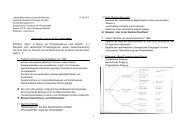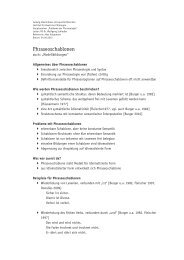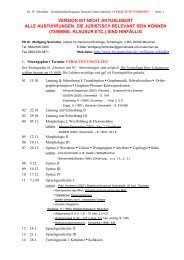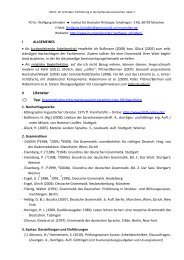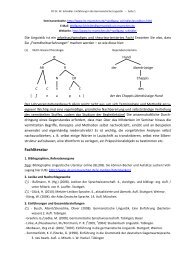Chapter 18 Lexical Functions: Description of Lexical Relations in a ...
Chapter 18 Lexical Functions: Description of Lexical Relations in a ...
Chapter 18 Lexical Functions: Description of Lexical Relations in a ...
You also want an ePaper? Increase the reach of your titles
YUMPU automatically turns print PDFs into web optimized ePapers that Google loves.
—<strong>Chapter</strong> <strong>18</strong>. <strong>Lexical</strong> <strong>Functions</strong>— 96<br />
describe rigorously and systematically collocations, or what can be also called semi-phra-<br />
semes. That theoretical contribution is dealt with <strong>in</strong> some detail <strong>in</strong> <strong>Chapter</strong> 21. Furthermore,<br />
they are essential <strong>in</strong> the theory <strong>of</strong> syntax, s<strong>in</strong>ce several syntactic regularities have to be described<br />
<strong>in</strong> terms <strong>of</strong> LFs. Cf., e.g., (19) [from Abeillé 1988]:<br />
(19) a. K<strong>in</strong>g John launched [= IncepOper 1] an attack aga<strong>in</strong>st the city.<br />
vs.<br />
Which city did K<strong>in</strong>g John launch an attack aga<strong>in</strong>st?<br />
It is aga<strong>in</strong>st this city that K<strong>in</strong>g John launched an attack.<br />
b. K<strong>in</strong>g John watched an attack aga<strong>in</strong>st the city.<br />
vs.<br />
*Which city did K<strong>in</strong>g John watch an attack aga<strong>in</strong>st?<br />
*It is aga<strong>in</strong>st this city that K<strong>in</strong>g John watched an attack.<br />
Extraction <strong>in</strong> such constructions is possible/impossible accord<strong>in</strong>g to whether the verb <strong>in</strong> question<br />
is/is not an LF <strong>of</strong> its Direct Object (<strong>in</strong> launch an attack it is, <strong>in</strong> watch an attack it isn’t).<br />
Here, however, I will limit myself to shedd<strong>in</strong>g some light on the use <strong>of</strong> LFs <strong>in</strong> computa-<br />
tional l<strong>in</strong>guistics.<br />
Basically, I know <strong>of</strong> three major ways <strong>in</strong> which LFs prove useful (or even <strong>in</strong>dispensable)<br />
for computer-oriented l<strong>in</strong>guistic descriptions:<br />
• As a tool for determ<strong>in</strong><strong>in</strong>g correct lexical choices with<strong>in</strong> phrases (all LFs): COLLOCATIONAL<br />
aspect.<br />
• As a tool for determ<strong>in</strong><strong>in</strong>g lexical choices necessary to adapt the DSynt-Structure <strong>of</strong> the<br />
sentence to be synthesized to its Communicative Structure (some verbal syntagmatic LFs,<br />
namely—support, causative and fulfillment verbs): COMMUNICATIVE aspect.<br />
• As a tool for determ<strong>in</strong><strong>in</strong>g lexical choices necessary to ensure the coherence <strong>of</strong> the text to be<br />
synthesized (some paradigmatic LFs): LEXICAL-COHESIONAL aspect.<br />
8.1 LFs and <strong>Lexical</strong> Choices<br />
The use <strong>of</strong> LFs for f<strong>in</strong>d<strong>in</strong>g the correct collocates is rather straightforward. Thus, under Mach<strong>in</strong>e<br />
Translation at the level <strong>of</strong> DSynt-Structure (i.e., without go<strong>in</strong>g through a SemR), it suffices to<br />
reduce the source language collocation (= which is to be translated) to its LF-representation, then<br />
translate the keyword only and then, f<strong>in</strong>ally, to select the value <strong>of</strong> the LF for the translation <strong>of</strong> the<br />
keyword <strong>in</strong> the target language. For <strong>in</strong>stance, Fr. Jean m’a détourné de cette habitude is<br />
reduced—via a monol<strong>in</strong>gual French dictionary which lists the values <strong>of</strong> all LFs for all head LUs<br />
to its DSyntS (20). Then, on the stage <strong>of</strong> transfer, the French DSynt-tree (20) is replac-ed with the


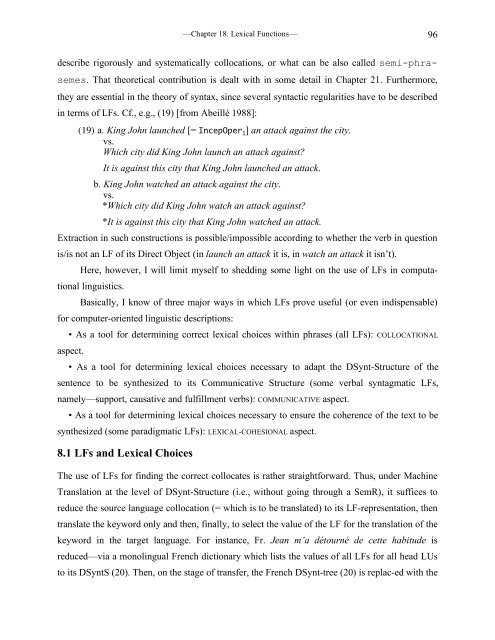
![E-Mail: Wolfgang.Schindler[ätt]germanistik.uni-muenchen.de Web ...](https://img.yumpu.com/51590147/1/184x260/e-mail-wolfgangschindlerattgermanistikuni-muenchende-web-.jpg?quality=85)
